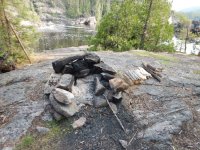I always cook on fire on my trips (unless there is a fire ban).
I was taught that on wilderness canoe trips you leave some firewood for the next group. When I leave camp, there is at least enough firewood left at the fire pit for a small cooking fire. I realize this is not a rule or a law, it's 'bush etiquette' and I don't mind arriving at a camp without firewood.
One thing I noticed while canoeing in Quetico this year is that some camps had leftover firewood thrown into the bushes away from the fire pit. I left firewood at one camp, and on a second visit about three weeks later, some of the leftover wood was burned and the rest scattered.
I can't think of an explanation for this. Did I miss something? What is the reason for such a practice?

I was taught that on wilderness canoe trips you leave some firewood for the next group. When I leave camp, there is at least enough firewood left at the fire pit for a small cooking fire. I realize this is not a rule or a law, it's 'bush etiquette' and I don't mind arriving at a camp without firewood.
One thing I noticed while canoeing in Quetico this year is that some camps had leftover firewood thrown into the bushes away from the fire pit. I left firewood at one camp, and on a second visit about three weeks later, some of the leftover wood was burned and the rest scattered.
I can't think of an explanation for this. Did I miss something? What is the reason for such a practice?

